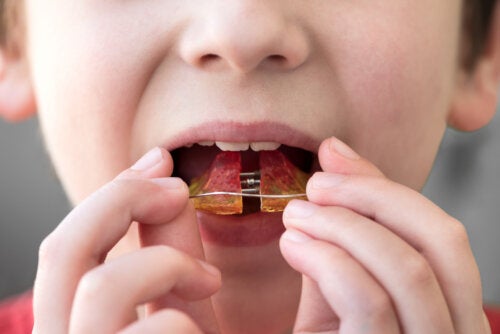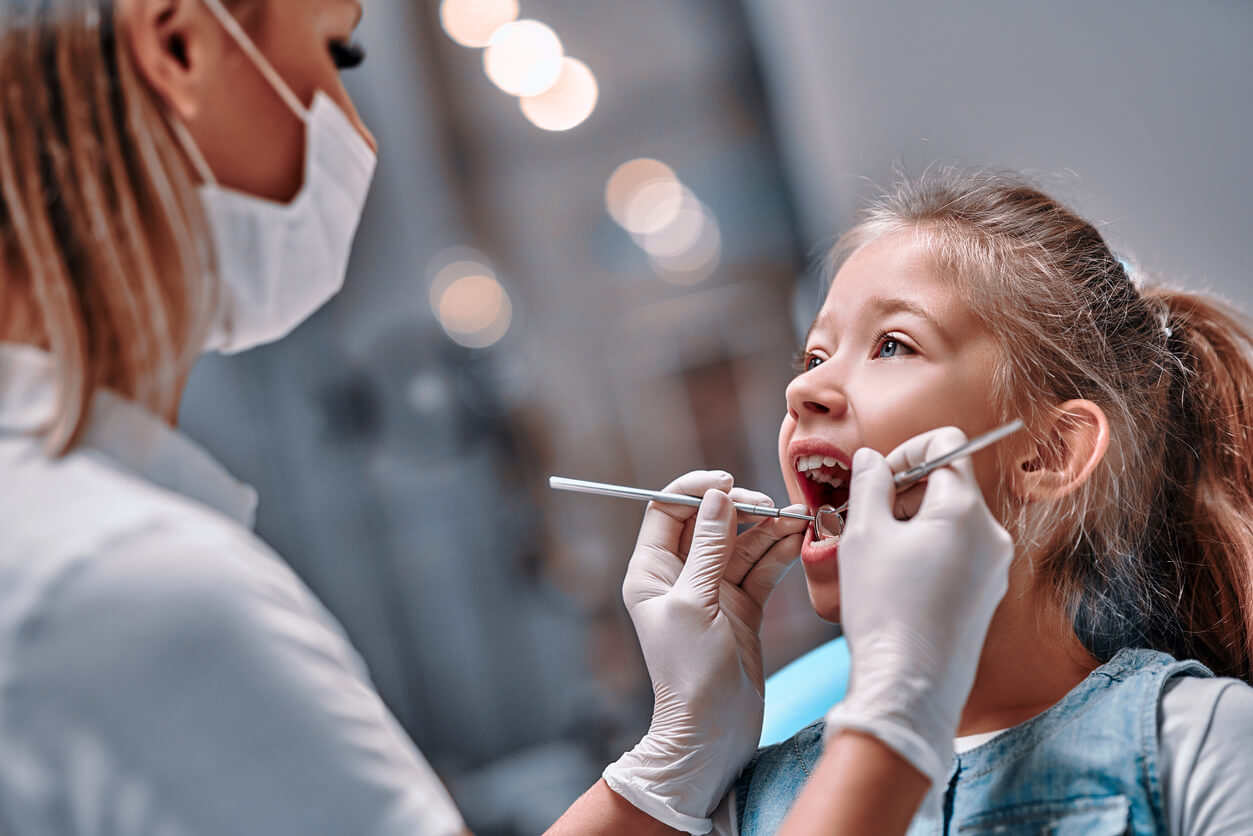Pediatric Orthodontics: When to Begin?

Parents often wonder at what age it is appropriate to begin pediatric orthodontics. Acting promptly and early allows bite problems to be addressed before they progress and worsen. Here, we’ll tell you what you need to know in detail.
Orthodontic treatments during childhood take advantage of the development stage of the jaws and the replacement of teeth. Acting at this time guides the growth of the bones and helps the teeth to be positioned where they should be. In this way, it’s possible to achieve balanced, functional, harmonious, and esthetic bites.
When to visit the orthodontist for the first time?
The Spanish Orthodontic Society (SEDO) recommends visiting an orthodontist for the first time at 6 years of age. At this stage, the baby teeth begin to fall out to be replaced by their permanent substitutes and the first permanent molars erupt. These events cause the coexistence of temporary and permanent elements. This is known as mixed dentition and is the ideal time to begin orthodontic treatment.
In general terms, the earlier any alterations in the mouth are diagnosed and corrected, the more comfortable, shorter, and more successful the treatment will be. For this reason, in some children, treatment can begin before the age of 6. If during regular check-ups, a professional detects a problem, they’ll make the corresponding referrals to an orthodontist.
If there are anomalies in the growth of the jaws or there’s any alteration in the eruption of the teeth, it’ll be necessary to consult with a specialist. It’s also pertinent to see an orthodontist if the child has dysfunctional habits. For example, breathing through the mouth, thumb sucking, nail biting, using a bottle or pacifier beyond the age of 2 years, or putting the tongue in the way when swallowing.
Likewise, if everything is going well during routine dental checkups, it’s appropriate to visit an orthodontist when the child begins to lose their baby teeth. Even if the development of the mouth seems normal, the specialist will evaluate in detail the oral conditions of the child. In this way, they’ll be able to determine whether or not treatment is necessary.

At what age is it best to start pediatric orthodontics?
In general, the appropriate age to start pediatric orthodontics is as soon as the bite problem is diagnosed. Seeking a solution immediately prevents the condition from progressing and aggravating the situation. When this occurs, a thorough evaluation of the case is done to plan the best treatment.
It’s important to take bite records, dental X-rays, and photographs of the inside and outside of the mouth. With the information provided by these examinations, measurements, projections, and studies are made to choose the best therapy to solve the condition.
The age of 6 years is the most appropriate time to start children’s orthodontic treatments. There are several reasons for this. We’ll tell you about them below.
Mixed dentition
As we’ve already mentioned, at the age of 6 years, the replacement of milk teeth by permanent teeth begins. The period of mixed dentition lasts until around the age of 12. If pediatric orthodontics is started at this age, it’s possible to reach the end of the eruption of the permanent teeth with enough space for all the elements to align properly in the arch.
The eruption of the permanent molars
Around 6 years of age is when the first permanent molars erupt in the back part of the mouth. The second molars erupt at around 12 years of age.
The molars at 6 years of age determine the chewing pattern of children and guide the positioning of the other permanent teeth that erupt later. Starting pediatric orthodontics at this age allows us to take advantage of this situation and use it in favor of the alignment of the permanent dentition.
Bone growth
The maxillary bones grow during childhood. By starting children’s orthodontics around the age of 6, it’s possible to guide or stimulate the proper development of bone structures.
Bone modeling is one of the main advantages of using braces during childhood. In fact, through interceptive orthodontics, it’s possible to avoid reaching the age of 12 with more severe bite problems.

Start child orthodontics at 12 years of age
If starting pediatric orthodontic treatments at an early age hasn’t been possible, 12 years of age is an opportune age. In adolescence, almost all the definitive dental elements are present.
At this stage, only the wisdom teeth are missing, which erupt around the age of 18. In addition, it’s an age in which the bones continue to grow. These characteristics are used to achieve a harmonious bite efficiently and quickly. To achieve the same results in adulthood, much more complex, long, and expensive treatments are necessary.
What type of orthodontics is used in children?
When it comes to treatment during childhood or adolescence, there are different alternatives. Depending on the age of the patient, the type of condition, and its severity, there are two types of orthodontics: Interceptive and corrective.
- Interceptive: This is used at an early age, before 12 years of age, to solve alterations in the jaws while they’re still growing. In general, these are removable appliances that guide and stimulate the bones of the mouth so that they develop correctly. In this way, the aim is to improve their shape, size, and positioning.
- Corrective: These treatments guide the teeth to their proper position, so they’re performed when tooth replacement is completed, around the age of 12. Fixed braces with brackets and invisible aligner systems, such as Invisalign are examples of this type of approach.
A timely consultation
Childhood is the ideal time to start orthodontic treatment. Acting early, when problems are just beginning, improves the function and esthetics of the mouth and face. In addition, it avoids more severe disorders and the need to resort to more complex and expensive treatments in the future.
In order not to miss the right time to correct bite problems in your children, you shouldn’t forget to have regular dental check-ups every 6 months. Seeing a pediatric dentist on a regular basis and consulting with a professional from the age of 6 allows you to detect and treat any condition in time.
All cited sources were thoroughly reviewed by our team to ensure their quality, reliability, currency, and validity. The bibliography of this article was considered reliable and of academic or scientific accuracy.
- Alvarado Lasso, G. A., & Guevara Melo, M. J. (2022). Relación entre la posición vertical y sagital del primer molar permanente y las maloclusiones esqueléticas en radiografías de perfil de pacientes atendidos en la clínica de posgrado de la Universidad Cooperativa de Colombia sede Pasto.
- Cartes, P. J. G., Piffard, M. J. Z., Donaire, J. A. R., & Padilla, C. D. C. R. (2020). Principales beneficios de un tratamiento de ortodoncia en niños. Reciamuc, 4(1), 333-345.
- D’Arcangeli Vargas, C. A. (2022). Tratamientos de ortodoncia preventiva e interceptiva más utilizados en niños en la actualidad.
- Dopico, M., & Castro, C. (2015). Importancia del primer molar permanente y consecuencias clínicas de su pérdida en edades tempranas del desarrollo. Raao, 54(2), 23-27.
- Kuncio, D. A. (2021). Skeletal Changes in Non-invasive Orthodontic Treatment in Growing Patients. New York State Dental Journal, 87(2), 18-21.
- Marmolejos, C., & Ovalle, E. (2021). Ortodoncia interceptiva.
- Pattanaik, S., & Patnaik, S. (2019). An Introduction to Preventive Orthodontics. Indian Journal of Public Health Research & Development, 10(9).
- Rodriguez, G. N. P., Davila, Á. A. A., & Dávila, M. P. A. (2022). Beneficios de la implementación de ortodoncia interceptiva. RECIAMUC, 6(2), 69-78.
- Rojas Durand, O. A. (2019). Oclusión y ortodoncia.
- Torres, F. O. L., & Illescas, M. V. L. (2023). Importancia del tratamiento oportuno en ortodoncia: Revisión bibliográfica. Domino de las Ciencias, 9(2), 516-532.
